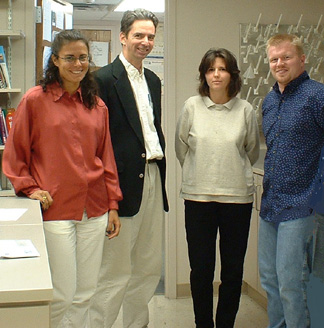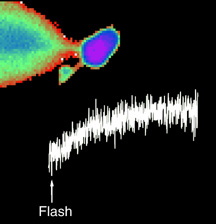 |
The laboratory team of Wallace Thoreson, Ph.D., second from left, includes Lucia Cadetti, Ph.D., Dr. Thoreson, Katalin Rabl, Ph.D. and Eric Bryson. |
Dr. Thoreson is lead author on the paper, titled, “A Highly Ca2+-Sensitive Pool of Vesicles Contributes to Linearity at the Rod Photoreceptor Ribbon Synapse.” Collaborating with him were: Katalin Rabl, Ph.D., UNMC Department of Ophthalmology and Department of General Zoology and Neurobiology, University of Pecs in Hungary; Ellen Townes-Anderson, Ph.D., Department of Neurology and Neurosciences, University of Medicine and Dentistry-New Jersey Medical School, Newark; and Ruth Heidelberger, M.D., Ph.D., Department of Neurobiology and Anatomy, University of Texas Health Science Center at Houston.
The researchers’ objective was to find out how light-sensing photoreceptor cells in the retina communicate to second order nerve cells in the retina and ultimately to the brain.
“We were interested in the release of chemical messages and how calcium regulates the release of these chemical messages,” Dr. Thoreson said. “We found some striking differences between photoreceptors and other neurons in the central nervous system.”
For example, the researchers found the release of chemical messages from rod receptors is triggered by unusually small amounts of calcium, compared to other nerve cells.
“Another difference we found was a much more linear release from photoreceptors than from other types of nerve cells,” Dr. Thoreson said. “This linear relationship between calcium and release is important because it allows rods to accurately communicate small changes in light.”
 |
Rod (and recording electrode) filled with a calcium-sensitive dye used to measure calcium levels in the cell. Abruptly increasing calcium in the rod (arrow) stimulates an increase in membrane capacitance in the rod that reflects release of the chemical message, glutamate. |
“We’ve described an unusual mechanism that other researchers working on nerve cell communication in the brain should consider,” he said.
Dr. Thoreson and his team are pursuing further research in this area, including differences between rods and cones. Rods allow people to see at night and cones allow people to see color in the daytime.
For more information about Neuron, go to www.neuron.org.